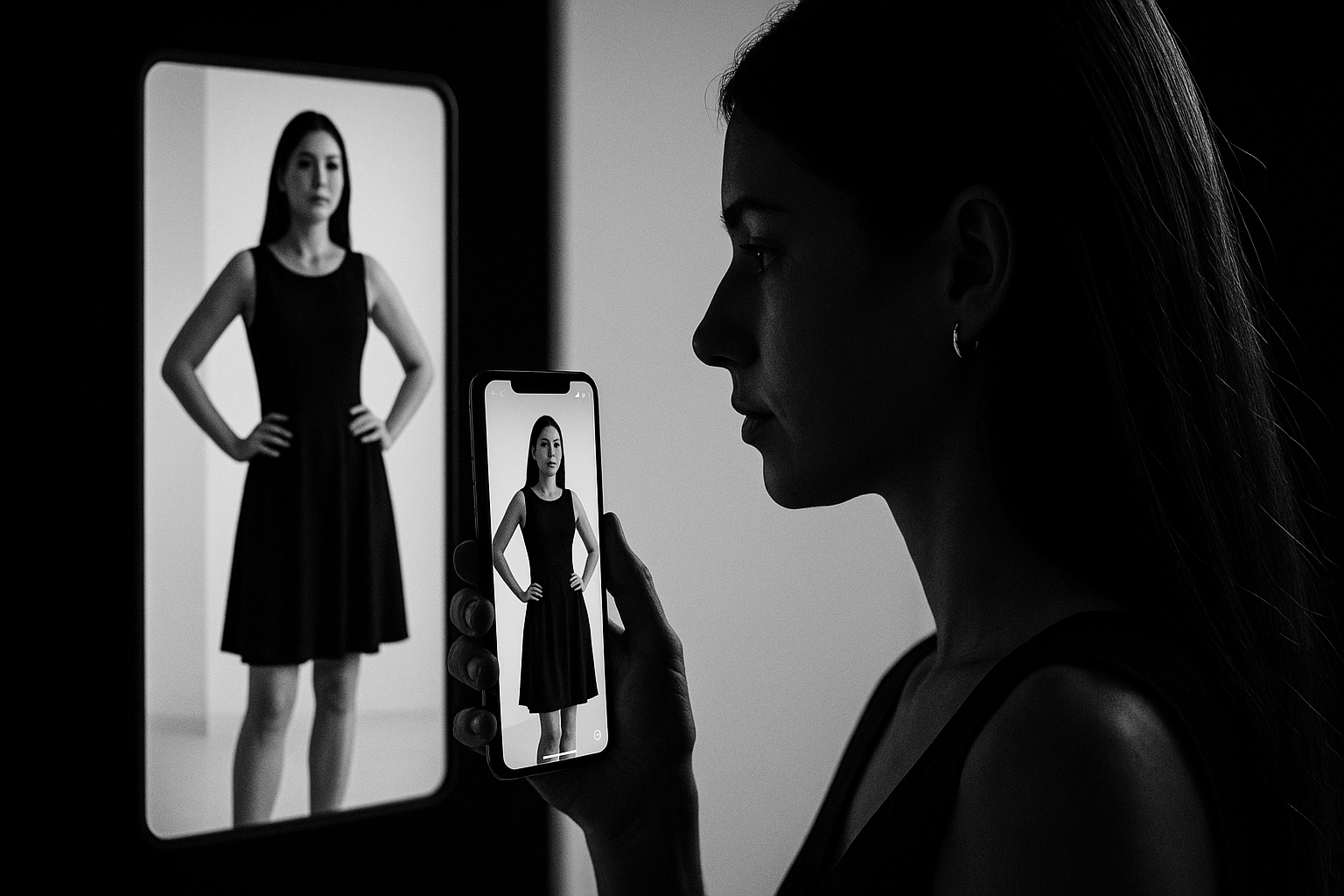AR’s Stylish Takeover: Shopping Meets Sci-Fi
Not long ago, the idea of virtually trying on clothes before buying them sounded like something out of science fiction. Today, it’s quickly becoming a staple of modern shopping. Augmented Reality (AR) has made its way from gaming and social media into the heart of fashion and retail, offering consumers a new, immersive way to interact with products without stepping into a store.
From luxury brands to fast fashion, retailers are adopting AR virtual try-on technology to meet evolving consumer demands. Using only a smartphone or laptop camera, shoppers can now “wear” a jacket, see how sunglasses look on their face, or test different shoe styles with a few taps. This technology does more than entertain, it builds confidence, reduces return rates, and brings the dressing room to wherever the consumer is.
As consumers demand more personalized and convenient experiences, AR try-ons offer a powerful solution that blends innovation with practicality. What once seemed futuristic is now an expectation, and it’s reshaping how we shop, market, and even design clothing. The fashion industry is facing a digital transformation and AR is leading the charge.
From Dressing Rooms to Digital Twins: A Fashion Revolution
The way we shop has always evolved with technology from department stores to online carts. But AR virtual try-ons represent a more radical leap. No longer tethered to fitting rooms, consumers are now interacting with digital twins of themselves and the products they want to wear. This shift marks a turning point not just in convenience but in the entire retail experience.
The pandemic acted as an accelerant, pushing brands to rethink in-person experiences. As stores closed and consumers stayed home, the fashion industry needed a way to bridge the physical gap. Augmented Reality became that bridge, allowing shoppers to see how a garment fits and flows in real time, even from the comfort of their couch.
Major brands like Nike, Gucci, and Warby Parker have already invested heavily in AR try-on features. Meanwhile, AR-native platforms like Wanna Kicks and Zero10 are setting new benchmarks in realism and interactivity. What was once a marketing gimmick is now a strategic necessity.
This evolution reflects a broader trend: consumers no longer just want products they want experiences. And in the world of fashion, AR is turning everyday shopping into something much more immersive and personalized.
Inside the Magic Mirror: How Virtual Try-Ons Actually Work
So how does the virtual try-on magic happen? Behind the sleek interface lies a blend of sophisticated technologies working in harmony. At its core, AR try-on systems use a device’s camera to map the user’s face or body, overlaying digital images of clothing or accessories in real time. But realism and precision come from much more than just image layering.
Most advanced systems employ 3D modeling, computer vision, and artificial intelligence. These tools analyze factors like body shape, movement, lighting, and texture to provide a seamless and responsive experience. Some platforms go a step further by using depth sensors or LiDAR (on supported smartphones) to improve accuracy and sizing.
For accessories like glasses or hats, facial recognition software ensures proper placement and scaling. For clothing, machine learning algorithms are trained on thousands of data points to predict how fabric should drape, stretch, and react to body movement.
The result? An interactive mirror that lets you see what you’d look like in an outfit without ever touching it. It’s fast, intuitive, and increasingly accurate, breaking down barriers that once made online fashion shopping a gamble. Virtual try-ons aren’t just digital, they’re dynamic, adapting to you in real time.
Why Shoppers Can’t Get Enough of Virtual Fitting Rooms
Consumers are embracing virtual try-ons with surprising enthusiasm and it’s not just about novelty. At the heart of the trend lies a clear benefit: control. Shoppers can now explore, experiment, and personalize their choices like never before. No more guessing how a pair of sunglasses will look or hoping a dress fits just right AR brings clarity and confidence to the buying process.
Convenience is a major driver. Virtual try-ons remove the friction of physical shopping: no lines, no dressing rooms, no pressure. Whether browsing on a lunch break or curled up at home, shoppers get an instant visual of how items suit them on their actual faces or bodies.
Accuracy also matters. Many platforms now offer near-photorealistic renderings that adapt to lighting, movement, and individual proportions. For consumers, this means fewer surprises when the product arrives and fewer returns. Retailers are reporting return rate reductions of up to 40% for items sold with AR preview options.
And then there’s the fun. Trying wild styles, mixing and matching outfits, or sharing try-on images on social media adds a layer of engagement that standard e-commerce simply can’t match. It’s fashion, filtered through innovation.
Brand Power-Up: How AR Is Reshaping Fashion & Marketing
For fashion brands, AR isn’t just a cool feature it’s becoming a cornerstone of competitive strategy. As online shopping dominates, brands are turning to virtual try-ons to create immersive, high-converting experiences that blur the line between digital and physical retail.
Retailers like Zara, ASOS, and Farfetch are integrating AR to elevate customer engagement. These tools keep users on websites and apps longer, boost conversion rates, and increase average order values. Instead of scrolling through static product images, shoppers interact with items in 3D transforming browsing into a dynamic experience.
Marketing, too, is evolving. Influencers and brands now use AR filters on platforms like Instagram and Snapchat to let followers virtually try on everything from lipsticks to sneakers. These interactive ads outperform traditional campaigns by driving deeper engagement and more memorable impressions.
For marketers and SEOs, AR brings new data opportunities: tracking try-on duration, engagement hotspots, and conversion triggers. These insights fuel more targeted campaigns and optimized content strategies.
In short, AR is no longer just an accessory to fashion. It’s a tool for deeper storytelling, smarter selling, and stronger brand loyalty. It’s reshaping how fashion is marketed, bought, and experienced across every channel.
Pixel-Perfect Futures: What’s Next for AR in Fashion?
As augmented reality continues its rise in fashion, the road ahead looks both exciting and complex. While AR try-ons are already transforming the retail experience, the technology is still evolving and so are the expectations of consumers.
One major challenge is standardization. Not all AR tools are created equal, and inconsistent quality can lead to frustration or mistrust. Shoppers expect smooth, realistic, and accurate try-ons every time, but that requires better hardware, faster networks, and smarter algorithms. As 5G and AI continue to advance, these gaps are expected to narrow rapidly.
Privacy and data ethics also loom large. AR systems often collect sensitive biometric data like facial scans and body measurements which raises concerns about security and consent. For technology to scale responsibly, transparency and robust privacy policies must be part of the package.
Despite these hurdles, the outlook is bright. AR is expanding beyond e-commerce into physical stores with smart mirrors, virtual mannequins, and interactive showrooms. Fashion designers are also exploring digital-only garments and virtual fashion shows.
As the digital and physical worlds fuse more tightly, AR is poised not just to enhance fashion it may redefine it. The future of try-ons is frictionless, fun, and fully virtual.
Ressources
- https://news.nike.com/news/nike-fit
- https://www.snapchat.com/news/post/gucci-augmented-reality-try-on
- https://techcrunch.com/2019/01/22/wanna-kicks/
- https://www.zero10.app/
- https://h-in-q.com/analytics/



